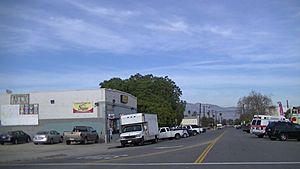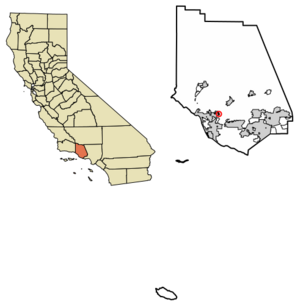Saticoy, California facts for kids
Quick facts for kids
Saticoy, California
|
|
|---|---|
 |
|

Location in Ventura County and the state of California
|
|
| Country | United States |
| State | California |
| County | Ventura |
| Established | 1861 |
| Named for | Ventureño name: Sa'aqtik'oy, "it is sheltered from the wind" |
| Area | |
| • Total | 0.373 sq mi (0.965 km2) |
| • Land | 0.373 sq mi (0.965 km2) |
| • Water | 0 sq mi (0 km2) 0% |
| Elevation | 154 ft (47 m) |
| Population
(2020)
|
|
| • Total | 1,133 |
| • Density | 3,038/sq mi (1,174.1/km2) |
| Time zone | UTC-8 (Pacific) |
| • Summer (DST) | UTC-7 (PDT) |
| ZIP code |
93004
|
| Area code | 805 |
| FIPS code | 06-84858 |
| GNIS feature IDs | 249159, 2585446 |
Saticoy (say "SAT-ih-koy") is a small community in Ventura County, California. It's not officially a city, but it's a place where people live and work. The name comes from the Chumash word Sa'aqtik'oy, which means "it is sheltered from the wind."
Saticoy was once one of the biggest settlements for the Chumash people. Today, it's a quiet area with about a thousand residents. You can still see historic buildings that show how important farming was here. These include the Walnut Growers Association Warehouse and the Saticoy (Lima) Bean Warehouse.
Near the Santa Clara River, there's a busy industrial area. Saticoy's history, its friendly neighborhood, the railroad, and easy access to main roads make it a special farming community in Ventura County.
Contents
What's in a Name?
The name Saticoy comes from the Spanish version of a Ventureño Chumash village name. That name was Sa'aqtik'oy, and it means "it is sheltered from the wind."
A Look at Saticoy's History
The very first people known to live in this area were called the Oak Grove People. In 1932, some old grinding stones from this ancient tribe were found near Saticoy. They were about 5,000 years old! Around the early 1400s, the Chumash tribe moved into the area. They were skilled at building canoes and grinding acorns for food.
Chumash Village Life
The Chumash village of Sa'aqtik'oy was one of the largest in their region. This region stretched from Point Conception to Santa Monica. Natural underground springs in Saticoy made it a perfect spot for the tribe to hold their important yearly meetings.
In 1769, Spanish explorers, led by the Portola expedition, were the first Europeans to visit this part of California. They camped near Saticoy on August 13. A missionary with them, Fray Juan Crespi, wrote that they saw a native village with twenty round houses made of grass.
Early American Settlers
Saticoy is located on a large piece of land called Rancho Santa Paula y Saticoy. This land was given to Manuel Jimeno Casarin by the Mexican government in 1840.
In November 1861, Jefferson L. Crane settled where the Chumash village used to be. Other Americans soon followed. Saticoy had a school as early as 1868. W.D.F. Richards, who is seen as the founder of Saticoy, arrived in 1868. He bought a lot of land and helped build the community. He also tried many new ways of farming.
The Saticoy Post Office opened in 1873. By 1890, it was one of seventeen post offices in the county. The streets of "Old Town" Saticoy were planned in 1887. This happened when a new railroad line was built through the area.
Growth and Changes
For many years, "Old Town" Saticoy grew as a center for farming. It was known for producing citrus fruits, beans, and other crops. The train service for passengers stopped in 1934.
The Saticoy School was built in 1900. Today, it's called ATLAS Elementary: Academy of Technology and Leadership at Saticoy. It's part of the Ventura Unified School District. Over time, the nearby city of Ventura grew and took over most of Saticoy, except for the "Old Town" area.
Many bridges have been built across the Santa Clara River at Saticoy. They often washed away during heavy rains and floods. A big flood in 1928, caused by the collapse of the St. Francis Dam, destroyed the bridge. The bridge was also washed out in a flood in 1969.
Cabrillo Village: A Special Community
Cabrillo Village was a camp for farm workers built in the 1930s. In the 1970s, the farm owners wanted to tear down the homes. But in 1976, 82 farmworker families worked together and bought their homes. This was a very special event, as it was one of the first times U.S. farmworkers bought the camp they lived in!
They formed the first cooperative housing group in Ventura County. The homes in Cabrillo Village are now owned by this cooperative. In 1994, Cabrillo Village became part of the city of Ventura.
Saticoy's Location and Environment
Saticoy is located where the Santa Clara River meets the Oxnard Plain. This area is very fertile, meaning it's great for farming. Farmers here grow avocados, lemons, oranges, strawberries, and many other crops.
East of town, near the river, is the Saticoy Oil Field. Oil was discovered here in 1955. The city of Ventura is right next to Saticoy on its north and west sides.
Who Lives in Saticoy?
According to the 2010 United States Census, Saticoy had a population of 1,029 people. Most of the people living in Saticoy are of Hispanic or Latino background.
Many families with children live in Saticoy. About 32% of the population is under 18 years old. The average household in Saticoy has about four people.
Fun and Learning in Saticoy
The Saticoy library has a new, modern building. It used to be a hardware store, but it was changed into a high-tech learning center. It's a great place for students to find resources and learn new things.
Saticoy also has a 9-hole golf course called Saticoy Regional Golf Course. It was first built in 1921. It's a flat and open course, perfect for golfers of all skill levels.
Getting Around Saticoy
State Route 118 runs through Saticoy. This road heads northwest as Wells Road and connects to the Santa Paula Freeway (State Route 126). If you head east on Los Angeles Avenue, which is also part of State Route 118, you can connect to State Route 232.
Utilities and Services
The City of Ventura provides water to Saticoy. Since Saticoy is outside the city limits, the water rates are a bit higher. The Saticoy Sanitation District handles the sewer services for the community.
See also
 In Spanish: Saticoy (California) para niños
In Spanish: Saticoy (California) para niños




